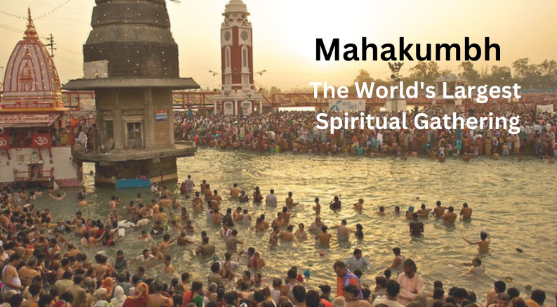The Mahakumbh, often referred to as the world’s largest spiritual gathering, is a grand event held in India that attracts millions of devotees, saints, and visitors from across the globe. This ancient Hindu festival is celebrated once every 12 years at four holy riverbank locations in India: Prayagraj (Allahabad), Haridwar, Ujjain, and Nashik. The event is deeply rooted in Indian culture, mythology, and spiritual traditions.
The Significance of Mahakumbh
The Mahakumbh holds immense religious and cultural significance. It is believed that during the festival, the sacred rivers are infused with divine nectar, or “Amrit,” making them holy. Taking a dip in these rivers during the Mahakumbh is considered a way to cleanse one’s sins and achieve spiritual liberation or “moksha.”
Mythological Origins
The origins of the Mahakumbh are tied to the ancient Hindu legend of the Samudra Manthan, or the Churning of the Ocean of Milk. According to mythology, gods and demons churned the ocean to extract nectar of immortality. During this process, a few drops of nectar spilled at the four locations where the Mahakumbh is celebrated today. These places became sacred, and the Mahakumbh commemorates this celestial event.
When and Where is Mahakumbh Celebrated?
The Mahakumbh rotates between four locations based on specific planetary alignments:
- Prayagraj (Allahabad): At the confluence of the Ganga, Yamuna, and the mythical Saraswati rivers.
- Haridwar: On the banks of the river Ganga.
- Ujjain: Along the Kshipra river.
- Nashik: On the banks of the Godavari river.
Each location hosts the festival once every 12 years, making it a once-in-a-lifetime experience for many attendees.
The Spiritual Atmosphere
The Mahakumbh is a vibrant and spiritual celebration where millions of devotees gather to perform rituals, offer prayers, and bathe in the holy rivers. The festival is marked by:
- The Sacred Bath (Shahi Snan): This is the most important ritual of the Mahakumbh, where devotees take a holy dip in the rivers.
- Processions of Saints: Ascetics, yogis, and sadhus from various sects lead colorful processions, chanting hymns and performing traditional practices.
- Religious Discourses: Spiritual leaders and scholars deliver sermons and teachings on Hindu philosophy and culture.
- Cultural Programs: The event also features music, dance, and theatrical performances showcasing India’s rich heritage.
Types of Kumbh Melas
In addition to the Mahakumbh (every 12 years), there are other Kumbh Melas celebrated more frequently:
- Ardh Kumbh Mela: Held every 6 years.
- Kumbh Mela: Held every 12 years but alternates between the four locations.
- Magh Mela: An annual event held at Prayagraj.
Global Recognition
The Mahakumbh is recognized as the largest peaceful gathering in the world. In 2013, over 100 million people attended the Kumbh Mela in Prayagraj, setting a record. The event has also been inscribed on UNESCO’s Representative List of Intangible Cultural Heritage.
Modern-Day Mahakumbh
While the festival maintains its traditional roots, modern infrastructure, and technology have transformed the Mahakumbh experience. Authorities ensure safety, crowd management, and sanitation for the millions of pilgrims. Facilities like mobile apps, live-streaming of rituals, and special transport arrangements make the event accessible to people from all walks of life.
Why You Should Experience Mahakumbh
The Mahakumbh is more than a religious event—it’s a cultural phenomenon. It offers a unique opportunity to witness the spiritual fervor of India, explore its rich traditions, and connect with like-minded seekers. Whether you’re a devotee or a curious traveler, the Mahakumbh is a once-in-a-lifetime experience that leaves a lasting impression.
Conclusion
The Mahakumbh is a celebration of faith, spirituality, and community. Its sheer scale and cultural richness make it a marvel to behold. For millions, it is a journey of self-discovery and divine connection. Attending the Mahakumbh is not just about participating in rituals—it’s about embracing a tradition that has been alive for centuries, bringing people together in their quest for peace and enlightenment.



More Stories
Christmas Markets in Europe You Can’t Miss
5 Charming Swiss Villages You Can’t Miss
Top 5 Things to do at Dubai Parks and Resorts